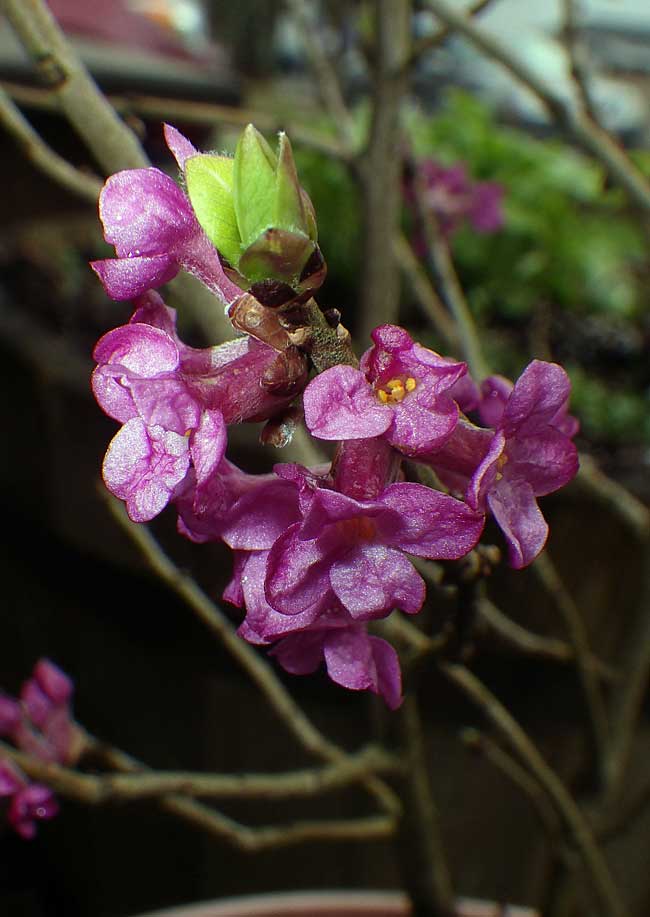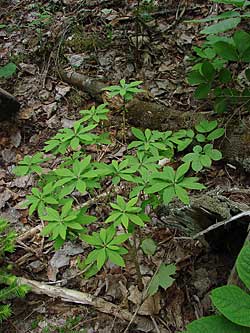
Daphne mezereum, April 28, 2014 From our Acadian heritage, and strictly ornamental (all parts extrement poisonous)! Photos by JackPine Below are some comments about Acadian plants on an "orphaned page" on eastlink (Apr 25, 2006) - if anyone knows of the author, please let us know. Thanks. HISTORICAL PLANTS - LEGACY FROM THE ACADIANSDespite the spate of cold, rainy weather, it's flowering now in the countryside, a sparse, pink-blossomed shrub with a historical connection. The Daphne was brought here by the Acadians, and never having spread far, it persists today in scattered pockets near what were once Acadian settlements. Given its origin, it's no coincidence that the Daphne usually can be found growing wild near Grand Pre, in White Rock and Pereau.You could call the Daphne a historical plant in the sense that it's connected with the old Acadians. There are many plants growing wild and cultivated here with the same connection. The Daphne is only one of many now common plants introduced by the Acadians. Some, like the Daphne, were cultivated for decorative purposes, but most were grown for practical uses, as dyes, in medicine and as food supplements. One of the most intriguing plants is the wild white strawberry. Until I talked recently with Reg Newell and his wife, botanist Ruth Newell of the E. C. Smith Herbarium in Wolfville, I wasn't aware this plant existed. Ms. Newell told me the white strawberry - so named because its berry is white - is believed to have been introduced by the Acadians and may have been used medicinally. The white strawberry is extremely rare and only can be found in a few places. Ms. Newell said she's seen the plant in White Rock along the Gaspereau River and in a rough brookside area near Oak Avenue in Wolfville. It's said that some of the plants introduced by the Acadians are clues to the existence of their old settlements. In other words, they're often found in abundance near an Acadian homesite. While it's apparently common in Kings County today, the presence of the introduced Red Fly Honeysuckle may offer clues to Acadian activity in at least one part of the county. The editors of the Natural History of Kings County twice mention the possibility of an Acadian tidal mill once existing on Elderkin Creek between Kentville and New Minas. The site is ideal for such a mill, the editors say, but the "only evidence of its existence is the presence of plants typical of those grown by the Acadians." One of those plants is the Honeysuckle. Many plants had medicinal uses, some were used in the kitchen; but not all that came down to us today are a welcome Acadian legacy. One such plant is the Buckthorn. The Acadians introduced Buckthorn, which may have been used as a hedge but according to Ruth Newell was used medicinally. Newell says the Buckthorn, which is common in the Wolfville area, "has a habit of taking over." Today, she says, "it is recognised as a serious invasive species." While plants (and trees) introduced by the Acadians are said to offer clues to the existence of homesites, many have spread well beyond known settlement areas and are common. Still, they have a historical connection in that they were once part and parcel of the Acadian lifestyle. Besides the Daphne and Honeysuckle, other plants mentioned in A Natural History of Kings County as introduced by the Acadians include Wormwood, Chicory, Slender Vetch, Caraway, Hops and Tansy. The next time you see any of these plants, remember their Acadian connection and how they were once used in their homes. Think of them as one of our most lasting Acadian legacies.) |
